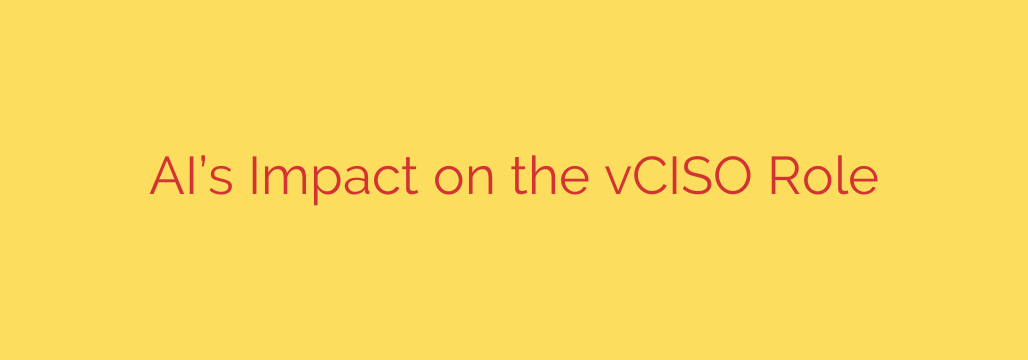
The Future of Cybersecurity Leadership: How AI is Reshaping the vCISO Role
In today’s rapidly evolving digital landscape, the twin pressures of sophisticated cyber threats and a persistent skills shortage have created a perfect storm for businesses. For many organizations, particularly small and medium-sized enterprises, the solution has been the Virtual Chief Information Security Officer (vCISO)—an on-demand expert providing strategic security leadership without the cost of a full-time executive.
Now, a new force is transforming this critical role: Artificial Intelligence (AI). Far from making the vCISO obsolete, AI is amplifying their capabilities, automating mundane tasks, and elevating their focus from the technical weeds to high-stakes strategic guidance. Understanding this shift is crucial for any business serious about its security posture.
AI as a Force Multiplier: Doing More with Less
The core challenge for any security leader is being overwhelmed by data. Logs, alerts, and threat intelligence feeds create a constant stream of noise that can obscure real threats. This is where AI is a game-changer for the vCISO.
Automated Threat Detection and Triage: AI-powered security platforms can analyze billions of data points in real-time, identifying anomalies and potential threats with a speed and accuracy no human team can match. This automates the initial, time-consuming phase of threat hunting. Instead of spending hours sifting through logs, the vCISO receives prioritized, context-rich alerts, allowing them to focus immediately on verification and response strategy.
Predictive Risk Modeling: Modern AI doesn’t just react to what’s happening; it predicts what could happen. By analyzing an organization’s unique environment against global threat trends, AI can identify likely attack vectors and vulnerabilities before they are exploited. This empowers the vCISO to move from a reactive to a proactive security stance, recommending preventative controls based on data-driven risk assessments.
The Strategic Shift: From Technician to Business Advisor
With AI handling much of the low-level data analysis and repetitive tasks, the vCISO is liberated to concentrate on what truly matters: strategy, communication, and risk management. This is where the human element becomes more valuable than ever.
The vCISO of the future spends less time in dashboards and more time in the boardroom. Their value is measured by their ability to:
Translate Technical Risk into Business Impact: AI can identify a vulnerability, but it can’t explain to a CEO why a specific server needs to be patched now in terms of potential revenue loss, reputational damage, or regulatory fines. The vCISO’s primary role is becoming that of a translator and trusted advisor.
Develop and Oversee Security Programs: With a clearer, AI-filtered view of the threat landscape, the vCISO can more effectively design and manage comprehensive security programs. This includes developing policies, leading compliance efforts, and ensuring the right security controls are implemented and optimized.
Manage Human-Centric Security: AI cannot run a phishing simulation, train employees to spot social engineering, or foster a culture of security awareness. The vCISO remains the essential leader for the human side of cybersecurity, which remains the weakest link in many organizations.
The Double-Edged Sword: Defending Against AI-Powered Attacks
It’s crucial to acknowledge that attackers are also leveraging AI. Threat actors are using artificial intelligence to create highly convincing phishing emails, generate polymorphic malware that evades traditional signatures, and automate reconnaissance at a massive scale.
A modern vCISO must not only use AI as a defensive tool but also understand how it is being used offensively. This knowledge is critical for developing resilient defense strategies that can withstand sophisticated, AI-driven attacks. An AI-aware vCISO will champion solutions like advanced endpoint detection, behavioral analysis, and a zero-trust architecture as essential defenses.
Key Security Takeaways for Your Organization
The integration of AI into cybersecurity is not a distant future—it’s happening now. Here’s how to prepare:
When Engaging a vCISO, Ask About AI: Inquire how a potential vCISO or security partner leverages AI and automation in their practice. Their ability to use these tools directly impacts their efficiency and the value they can provide your business.
Focus on Data-Driven Security: Embrace tools that provide clear, predictive insights. The goal is to make security decisions based on quantifiable risk, not just gut feelings or generic best practices.
Invest in Human Expertise: Technology is only part of the solution. The true power lies in combining advanced AI tools with the strategic judgment, experience, and communication skills of an expert security leader.
Ultimately, AI is making the vCISO more essential than ever. By automating the machine-scale tasks, it elevates the role to its highest and best use: providing the strategic, human-led guidance necessary to navigate the complex cyber risks of the modern world.
Source: https://www.helpnetsecurity.com/2025/07/31/vciso-services-adoption-2025/








